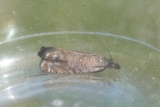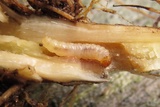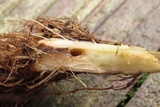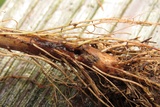Dichrorampha plumbana (Scopoli, 1763) Species
Last modified: Feb. 8, 2024, 3:47 p.m.
A rare species in many localities in Belgium. Status insufficiently known, because most of the species of this genus should be checked for genitalia.
Details
- Classification
- Family: Tortricidae > Subfamily: Olethreutinae > Tribus: Grapholitini > Genus: Dichrorampha > Species: Dichrorampha plumbana
- Vernacular names
- Geelstipwortelmot (NL), Lead-coloured Drill, Lead-coloured Daisy Moth (EN), Großer Schafgarben-Wurzelwickler (DE)
- Synonyms
- Dichrorampha saturnana Guenée, 1845 and Dichrorampha ulicana Guenée, 1845
- First mention in Belgium
- De Sélys-Longchamps E. 1844. Énumération des insectes Lépidoptères de la Belgique. — Mémoires de la Société royale des Sciences de Liége 2: 1–35. On page 20.
- Status
-
Native
Distribution
Imago
Wingspan 11–14 mm. Dark brown forewings with yellowish brown powdering in outer 2/3. Diffuse lighter brown spot halfway out at rear edge. Silvery lines in the outer part and several black dots along the outer edge near tornus.
Very similar to Dichrorampha sedatana and Dichrorampha aeratana and require genital examination to identify.
Flight periods
The adults have been seen from mid-April towards late August.
Observed on
- Host plant (species):
- Leucanthemum vulgare and Achillea millefolium
The larva lives on Leucanthemum vulgare or Achillea millefolium.
Habitat
It inhabits rough ground, flowery grasslands, waysides etc...




